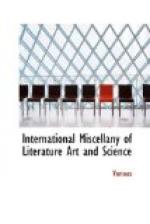“You sometimes have seen large circles of grass in the meadows trampled down. They are traced by the elves, as they dance in the summer night when the moon is shining. Wo to the wanderer, wo to the young girl, who at that time passes near them. The elves invite them to join in the dance, and sometimes drag them by force away. Into the veins of any one who comes within their circle, a secret poison is infused, which makes him languish and die. I tell you, I fear that Ebba, good and charitable as she is, has been surprised by those accursed beings; for she has the pale face and languid air of those who suffer from philtre of the elves.”
Sitting one morning in the room of her father, Ebba was discharging the task she had proposed to herself in jest. She was teaching Ireneus the elements of the beautiful Swedish language, of the Islandic from which it is derived, and which has its ulterior origin in the old tongues of India, the cradle of the great Gothic races. “It is pleasant,” says Byron, “to learn a foreign tongue from the eyes and lips of a woman.” Ireneus enjoyed all the luxury of such a system of instruction.
Without having what is called a poetical nature, he was not a little under the influence of the poetry of his situation, of the beautiful girl who taught him, of her sweet smile, and the affectionate voice which stimulated his zeal or reproved his mistakes. Any accidental question, any quotation, a single word often would hurry the young girl’s mind to her favorite theme, the mythology of the north.
In her early youth, she had studied the curious dogmas of the old Scandinavians, a singular assemblage of terrible symbols and smiling images borrowed from the flowery regions of the east, and of dark conceptions produced in the cloudy north.
Not only did she know all the tales, but in some sort she lived in the memory of the heroic and religious traditions sung in the solemn dithyrambics of the Edda, and met with in every page of the Islandic sagas. Though her heart was always Christian, she was amazed, from time to time, at hearing herself speak, like a pagan, of the beneficent Baldus, of Loki, the spirit of evil, and of Freya, the golden tears of whom formed the Baltic amber. To her, the world was yet peopled by the mythological beings, created by the naive faith of the north, and to them she had learned to adapt the phenomena of nature. When she heard the thunder, she thought of Thor, and his mighty hammer, driving across the heavens in his iron car. If the sky was clear, she thought the luminous Alfis lighted up the horizon.
In the pantheism of Scandinavian mythology, which, though less seductive, is less comprehensive than that of the Greeks, all that she heard assumed a mysterious existence. Plants were watered by the foam the horse of night shakes on the earth, as he tosses his mane and champs his bit.




